Related Research Articles
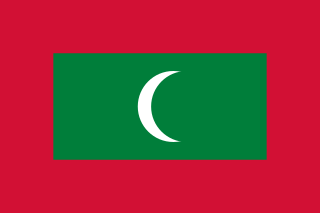
The Maldives, officially the Republic of Maldives, and historically known as the Maldive Islands, is a country and archipelagic state in South Asia in the Indian Ocean. The Maldives is southwest of Sri Lanka and India, about 750 kilometres from the Asian continent's mainland. The Maldives' chain of 26 atolls stretches across the equator from Ihavandhippolhu Atoll in the north to Addu Atoll in the south.
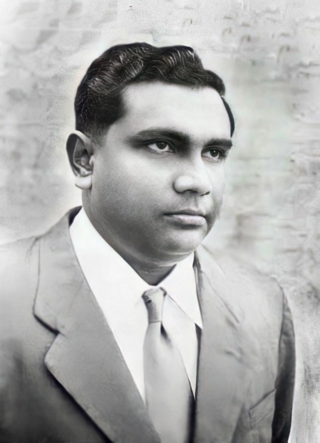
Ibrahim Nasir Rannabandeyri Kilegefan, KCMG, NGIV commonly known as Ibrahim Nasir, was a Maldivian politician adhering to the non-aligned ideology and staunch anti-imperialist. Nasir served as the Prime Minister of the Maldives from 1957 to 1968 under the monarchy, and later the first President of the Second Republic of Maldives from 1968 to 1978. Nasir served two terms, then he decided to retire, even though the People's Majlis voted him in for a third term. Nasir is remembered as an independence hero for guiding the Maldives to independence from the British Empire, he is also credited for establishing the tourism industry in the Maldives, as well as rapidly modernizing and developing the country and economy.
Addu City is a city in Maldives that consists of the inhabited islands of Addu Atoll, the southernmost atoll of the archipelago. Addu City is the second-largest urban area in Maldives, in terms of population, and is one of the two urban areas to get the status of "city" other than the capital city, Malé, and Fuvahmulah. Addu City has 6 districts. They are Hithadhoo, Maradhoo-Feydhoo, Maradhoo, Feydhoo, Hulhudhoo and Meedhoo. These divisions are naturally islands, but are well connected. In addition, Addu Atoll has other uninhabited islands.

Gnaviyani Atoll is one of the administrative divisions of the Maldives corresponding to the natural atoll, Fuvahmulah. Surfacewise this is the smallest administrative unit in the Maldives, situated on the Equatorial Channel between Huvadhu Atoll and Addu Atoll.

Fuvahmulah is an island (atoll) in the Maldives. It is under Maldives' administrative division of Gnaviyani Atoll. The island is the second southernmost administrative atoll, located to the south of Huvadhu Atoll and to the north of Seenu Atoll. It's also the third most populous island after Malé and Addu.
Rathafandhoo is an inhabited island of the Gaafu Dhaalu Atoll, Maldives.
Funadhoo is one of the inhabited islands of the Shaviyani Atoll administrative division and geographically part of the Miladhummadulhu Atoll in the Maldives. Funadhoo is a very common Maldivian place name and is derived from the Dhivehi name for the tree Calophyllum inophyllum which grows on the shores of some islands. It is the administrative capital of Shaviyani Atoll.

The culture of the Maldives is derived from a number of sources, the most important of which is its proximity to the shores of Sri Lanka and South India. The population is mainly Indo-Aryan from the anthropological point of view. Islam is considered the religion of the country and only Muslims can become legal citizens.

Nal Sarovar Bird Sanctuary, consisting primarily of a 120.82-square-kilometre (46.65 sq mi) lake and ambient marshes, is situated about 64 km to the west of Ahmedabad near Sanand Village, in the Indian state of Gujarat. Mainly inhabited by migratory birds in winter and spring, it is the largest wetland bird sanctuary in Gujarat, and one of the largest in India. It was declared a bird sanctuary in April 1969.

Hulhumeedhoo or Hulhudhoo-Meedhoo is an island located on the northeastern point of Addu City. It is the fifth largest island in the Maldives. Although Hulhumeedhoo is geographically one island, it is divided into two administrative constituencies of Addu City, known as Meedhoo and Hulhudhoo, which are roughly the northern half and southern half of Hulhumeedhoo respectively. The name "Hulhumeedhoo" is an amalgamation of the names Hulhudhoo and Meedhoo.

The wildlife of the Maldives includes the flora and fauna of the islands, reefs, and the surrounding ocean. Recent scientific studies suggest that the fauna varies greatly between atolls following a north–south gradient, but important differences between neighbouring atolls were also found, which may be linked to differences in fishing pressure – including poaching.
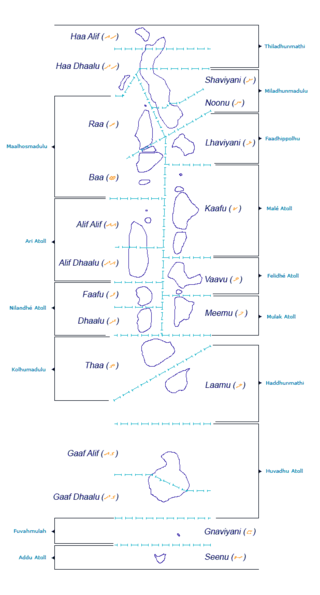
The Administrative Divisions of the Maldives refers to the various units of government that provide local government services in the Maldives. According to the Decentralization Act 2010, the administrative divisions of the Maldives would consist of atolls, islands, and cities; each administered by their own local council, under the basic terms of home rule. Geographically, the Maldives are formed by a number of natural atolls plus a few islands and isolated reefs which form a pattern from North to South. Administratively, there are currently 189 islands, 18 atolls and 4 cities in the Maldives.
Dhadimagu is an administrative division of Fuvahmulah, Maldives. It is the largest division of the island, located in the northern part of the island. Throughout history, many scholars and famous public figures came into being from this district housing many of the historical sites and landmarks of the island. A center of learning as well as an important location for the island's economy, the number of 'Hafiz's and teachers from this district outnumber that of any other district in Fuvahmulah, and this district is considered by many to be the most educated and learning-centered district of Fuvahmulah.
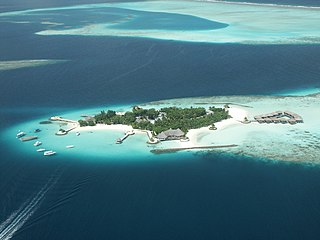
The fishing industry in the Maldives is the island's second main industry. According to national tradition in the words of former President Maumoon Abdul Gayoom, "Fishing is the lifeblood of our nation, it is inborn. From the soil on which we live, to the sea around us, it remains an integral part of our existence. Fishing, and our country and its people, [are] one and shall remain inseparable forever." The Maldives has an abundance of aquatic life and species of fish. Common are tuna, groupers, dolphin fish, barracuda, rainbow runner, trevally and squirrelfish and many more. Aside from being of essential importance to the economy, fishing is also a popular recreational activity in the Maldives, not only among locals but by tourists. The islands have numerous fishing resorts which cater for these activities.

Gen Miskit is one of the oldest mosque in the Maldives built c. 1300. It is made of coral stone and was built straight after the conversion to Islam. It's noted that this mosque isn't facing towards the Qibla.
Mulah Kandu, Dv. for "Mulah Channel", is the channel between Fuvahmulah and Addu Atoll.
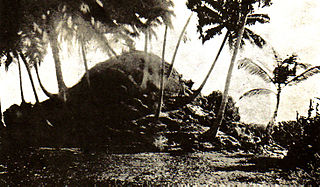
Fua Mulaku Havitta is the ruin of a Buddhist chaitya whose main feature is its ruined stupa. The Havitta is located at the northeastern end of Fuvahmulah, Maldives. It was historically located in Dhadimagu ward of the island, in an area which has now been annexed to Hoadhadu ward. Being the most important center of the Buddhist community in the pre-Islamic period, Dhadimagu was the last ward of the island to have accepted Islam. It was after the acceptance of Islam by the residents of Dhadimagu ward that the Havitta was buried under a mound of sand and one of the temples in the area was converted into a mosque to be known as Gemmiskiy. This happened in the early 1200s under the leadership of Abu Bakr Naib, who completed the conversion process in Fuvahmulah started by his great grandfather Yoosuf Naib in the year 1145 CE.
Miskiymagu is an administrative division of Fuvahmulah, Maldives. The former Dhashokubaa village was merged with Miskimmago.

Thoondu is a white sandy beach on the north of Fuvahmulah, Maldives. Located within Dhadimagu ward of the island, it is believed to be one of the most well known features of Fuvahmulah. Hundreds of people visit the beach every day, and this figure is much higher during special occasions like Maahefun. Thoondu has also been declared as a Protected area of Fuvahmulah by the government of Maldives on 12 June 2012 and the Atoll Council of Fuvahmulah has also passed a Decree to establish the place as a Protected area on 19 January 2012.
Bandaara Kilhi is one of the two fresh water lakes in Fuvahmulah, Maldives.
References
- ↑ "Photo of Khili". Panoramio. 11 December 2011. Archived from the original on 19 February 2014. Retrieved 23 June 2014.
- ↑ "Majid's Pages - Fuvah Mulaku Photos, society and culture". Maldives Royal Family. Retrieved 24 July 2024.
- ↑ "Common Moorhen; Exclusive Bird To Fuvahmulak In The Maldives". BLUEPEACE Maldives. 6 December 2011. Retrieved 24 June 2024.
- ↑ Fuvahmulah Maldives (29 November 2011). "Dhadimagi kilhi - "Wonderfully Unique"". Facebook . Retrieved 24 July 2024.
- ↑ "Three areas in Fuvahmulah island declared as Protected Areas". Ministry of Housing and Environment. 18 June 2012. Archived from the original on 19 February 2014. Retrieved 23 June 2014.
- ↑ "Dhandimagu kilhi". Maldives Protected Areas. Ministry of Climate Change, Environment and Energy. Retrieved 24 July 2024.